Efficient finishing

| Area | Up to two thirds of pitch |
| Equipment | Balls, bibs, cones, 2 full size goals |
| No. of Players | Up to 20 players + 2 goalkeepers |
| Session Time | Attacking crosses: 15mins 11v11 crossing game: 15mins Finishing zones: 20mins |
This session is all about finishing efficiently. It focuses on encouraging players to cross from favourable positions and it works on different types of delivery, whether that is to the back post, the near post, or pull backs to edge of box. Furthermore, it rehearses attacking players to take up positions in effective finishing zones to take advantage of these scoring chances.
I like this session because it ensures that crossing players have the capability to read their team mates’ movements in the finishing zone and deliver a suitable cross, either on the ground or in the air, to the near post or the back post, or a pull back.
It also teaches the players that if no one is in a finishing position, the cross should not be executed. If players are unable to cross, they should try to gain a corner, or make a pass to a supporting player in order to give attackers the time to position themselves to meet the delivery and finish efficiently on goal.
I would normally run this session once a week in preparation for the next game. If an opposing team’s stats show that they are conceding goals from wide areas, I would run the session twice a week.
“I like this session because it ensures that crossing players have the capability to read their team mates’ movements in the finishing zone”
ATTACKING CROSSES
We set up a playing area in the final third of the pitch with a full size goal and a goalkeeper at each end, creating two penalty areas. We’re using the full width of the pitch with a wide channel marked on each flank. We’re using 12 outfield players, split into two teams of six. It’s 4v4 in the central area and each team has a wide player at the attacking end of both wide channels. The wide players can either be full backs or wingers and they are responsible for executing the crosses for the four central players attacking the box.
Play starts with a pass out from a goalkeeper. The team in possession must get the ball to either of their attacking wide players as quickly as possible by playing through one of the four central players. As soon as the ball is played wide, the players of the possession team must attack the box, making well-timed runs to cover all key goal scoring areas. One of them should meet the cross and finish with a shot on goal, as shown [1].
The defending team must try to prevent them scoring. If a goal is scored, the exercise restarts from the opposition keeper.
The team that scores the most goals wins the exercise. Only goals scored from crosses count.
[1]
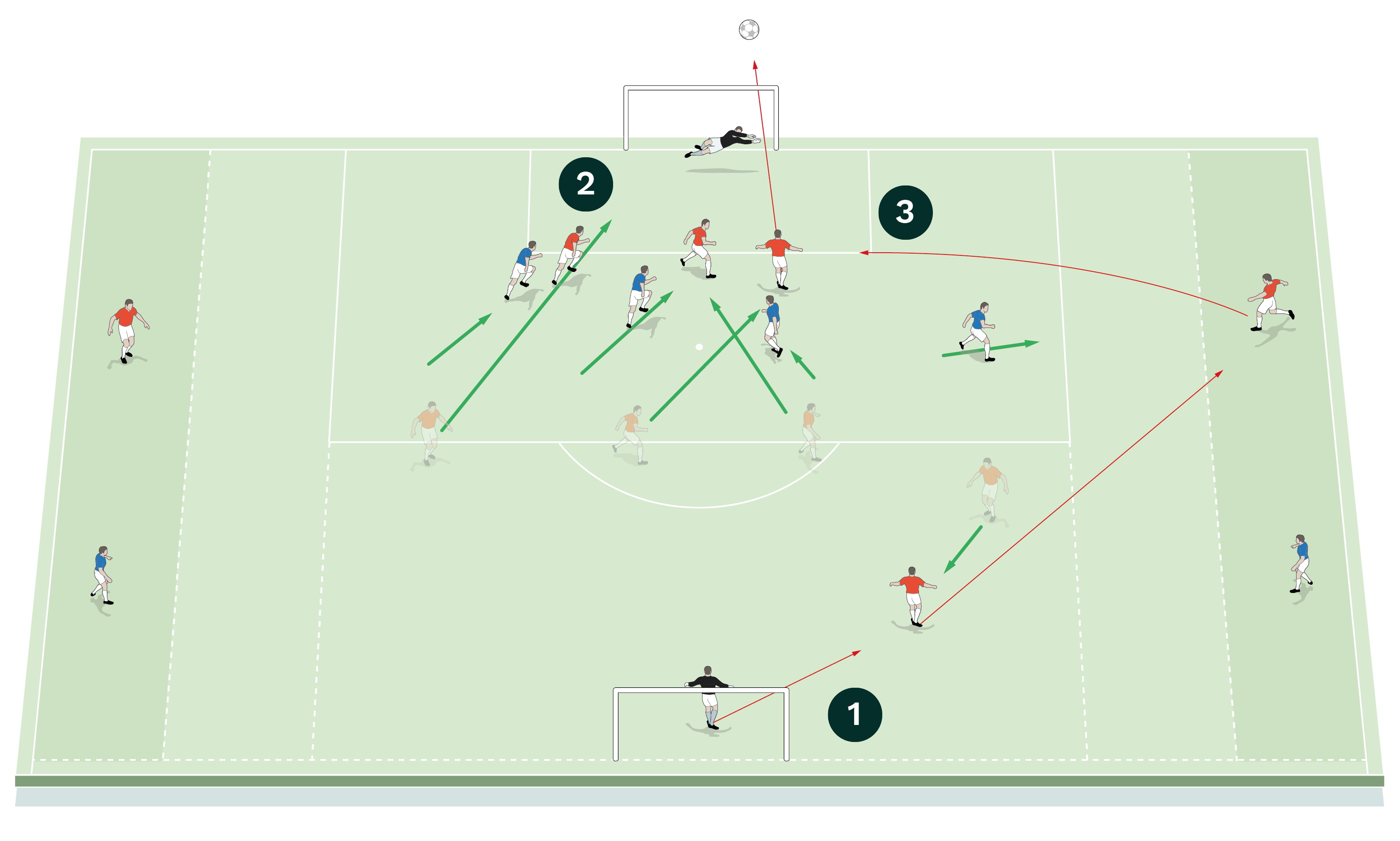
2. As soon as the ball is played wide, the possession team must attack the box, making well-timed runs to cover all key goal scoring areas
3. The wide player delivers a cross into the box. Goals only count if they are scored from crosses
11v11 CROSSING GAME
We set up a playing area between the penalty boxes of a pitch with a full size goal and a goalkeeper at each end. We’re using the full width of the pitch, with a wide channel marked on each flank.
We’re using 20 outfield players and two goalkeepers, split into two teams of 11. Each team has four players in the main area in each half and also a wide player locked in the attacking end of each wide channel. The wide players are only active when the ball is in the attacking half, meaning the team in possession attacks with an overload.
Play starts with a pass out from a goalkeeper and the aim for the possession team is to get the ball to one of the attacking wide players as quickly as possible. To speed up the attack, the pass can even be played directly to a wide player from a team mate in the defensive half, as shown [2a].
[2a]
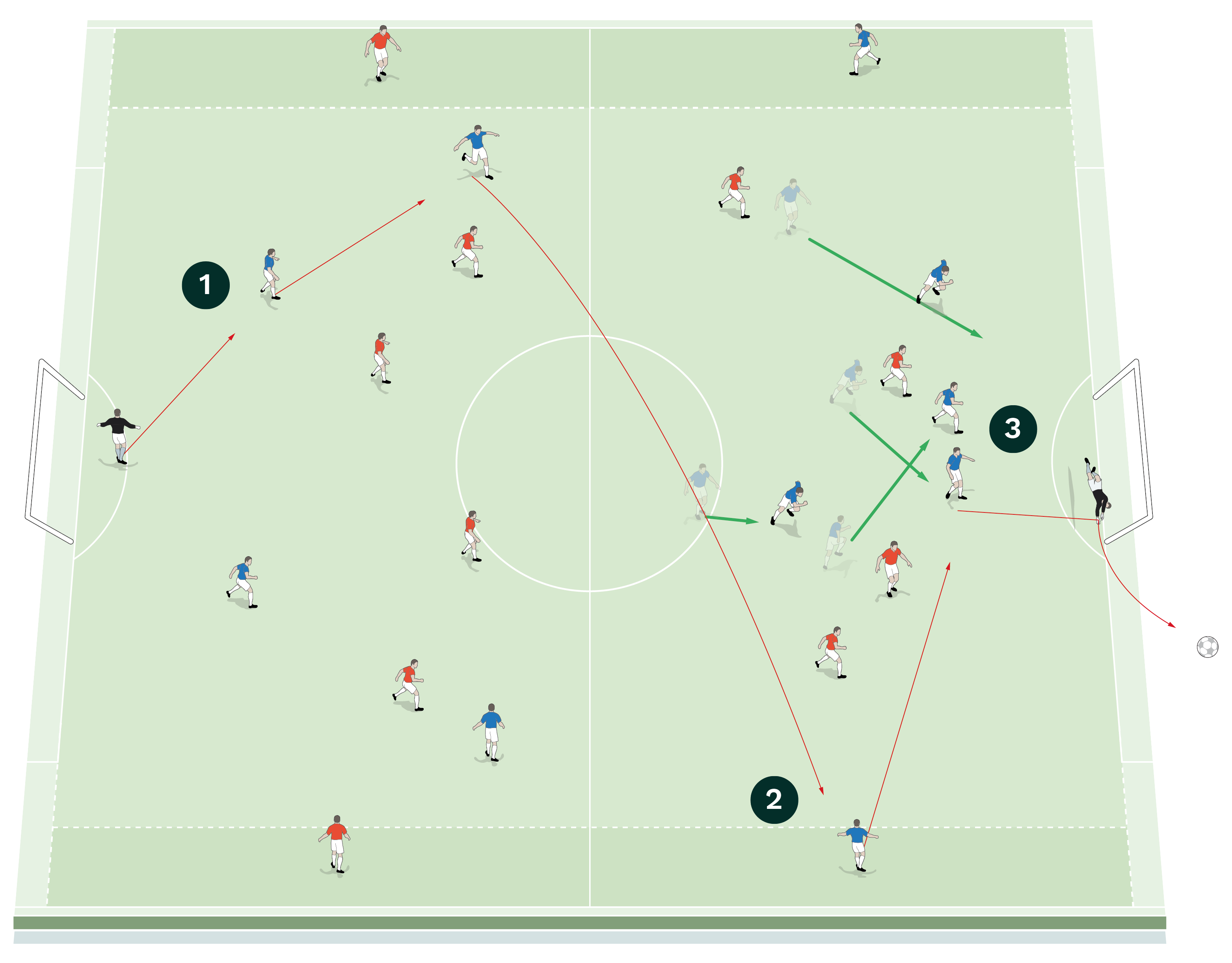
2. The aim for the possession team is to get the ball to one of the wide players as quickly as possible, even if the pass is made by a player in the defensive half
3. Once the ball is with a wide attacking player, the four central players in the attacking half aim to make well timed runs to arrive in key goal scoring areas to finish from a cross
Once the ball is with a wide attacking player, the four central players in the attacking half aim to make well timed runs to arrive in key goal scoring areas to finish from a cross.
Each wide player should check the movement of their attacking players prior to crossing and the position, movement, direction and speed of the attackers will determine what type of cross should be executed.
The team that scores the most goals in the exercise wins the game and goals only count if they are scored from a cross. If a goal is scored, the exercise restarts from the opposition goalkeeper.
The four defending players in the half being attacked must try to stop the attack and should launch a counter-attack using the same game principles if they win the ball.
To progress the session, the team in possession now must aim to link with a player in the attacking half before the ball is played out to a wide attacking player, as shown [2b]. All other rules and principles remain the same.
[2b]
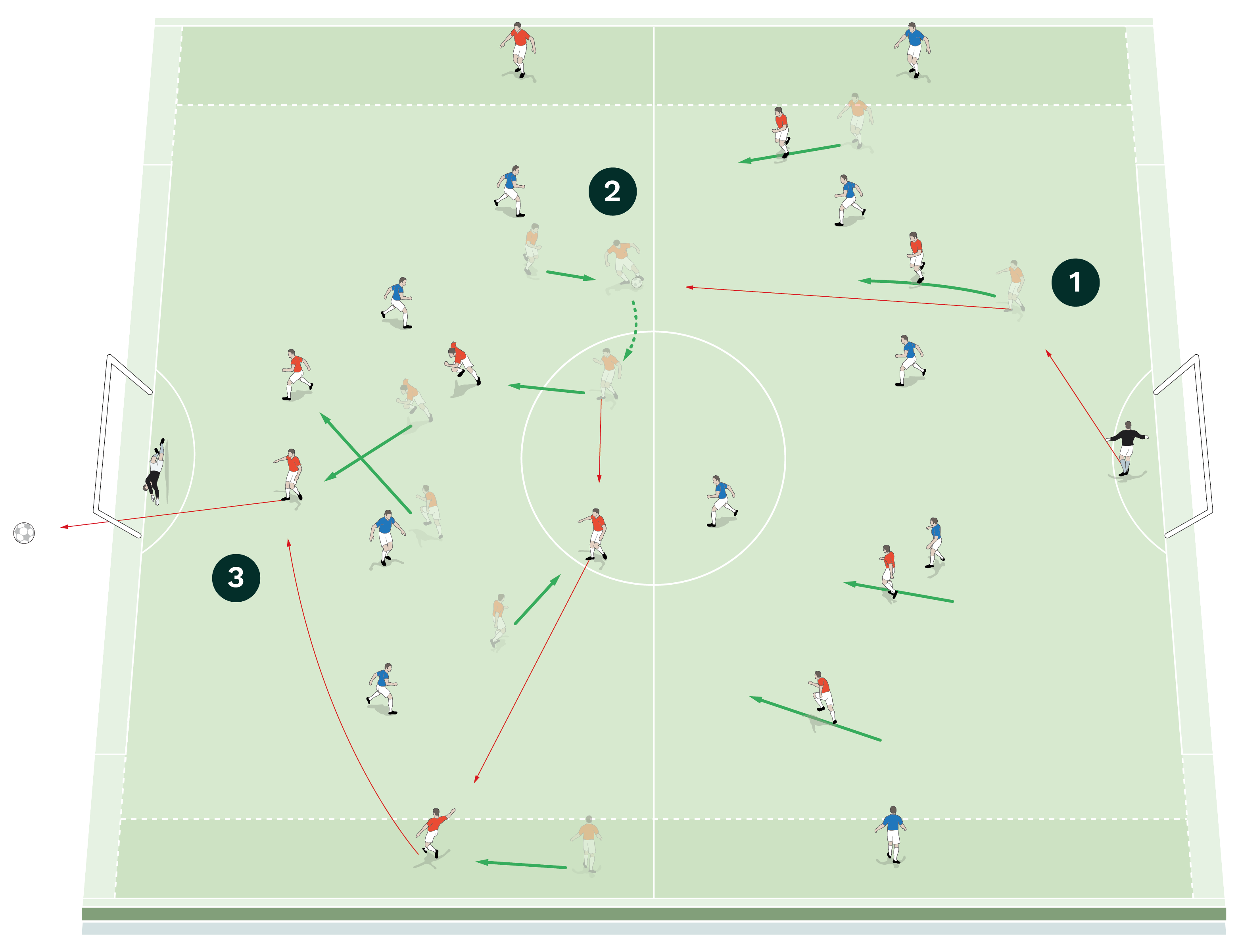
2. To progress the session, the team in possession must link with at least one player in the attacking half before the ball is played out to a wide attacking player in the wide channel
3. The wide player should check the movement of the attacking players prior to crossing to determine what type of cross should be executed
FINISHING ZONES
We set up a playing area on half a pitch, with a full size goal and a goalkeeper at each end. Three 5x5-yard finishing zones are marked in front of one goal, as shown.
We’re using 10 outfield players split into a blue attacking team of six, who attack the goal with the finishing zones marked in front of it, and a red defending team of four.
The practice starts with a goal kick from the goalkeeper of the red defending team. A player from the blue team receives the kick and the blues launch an attack via the wide areas. The attacking team has just 10 seconds to score a goal and the attackers must try to time their runs well to get into the optimal finishing boxes to score from the cross, as shown [3a].
[3a]
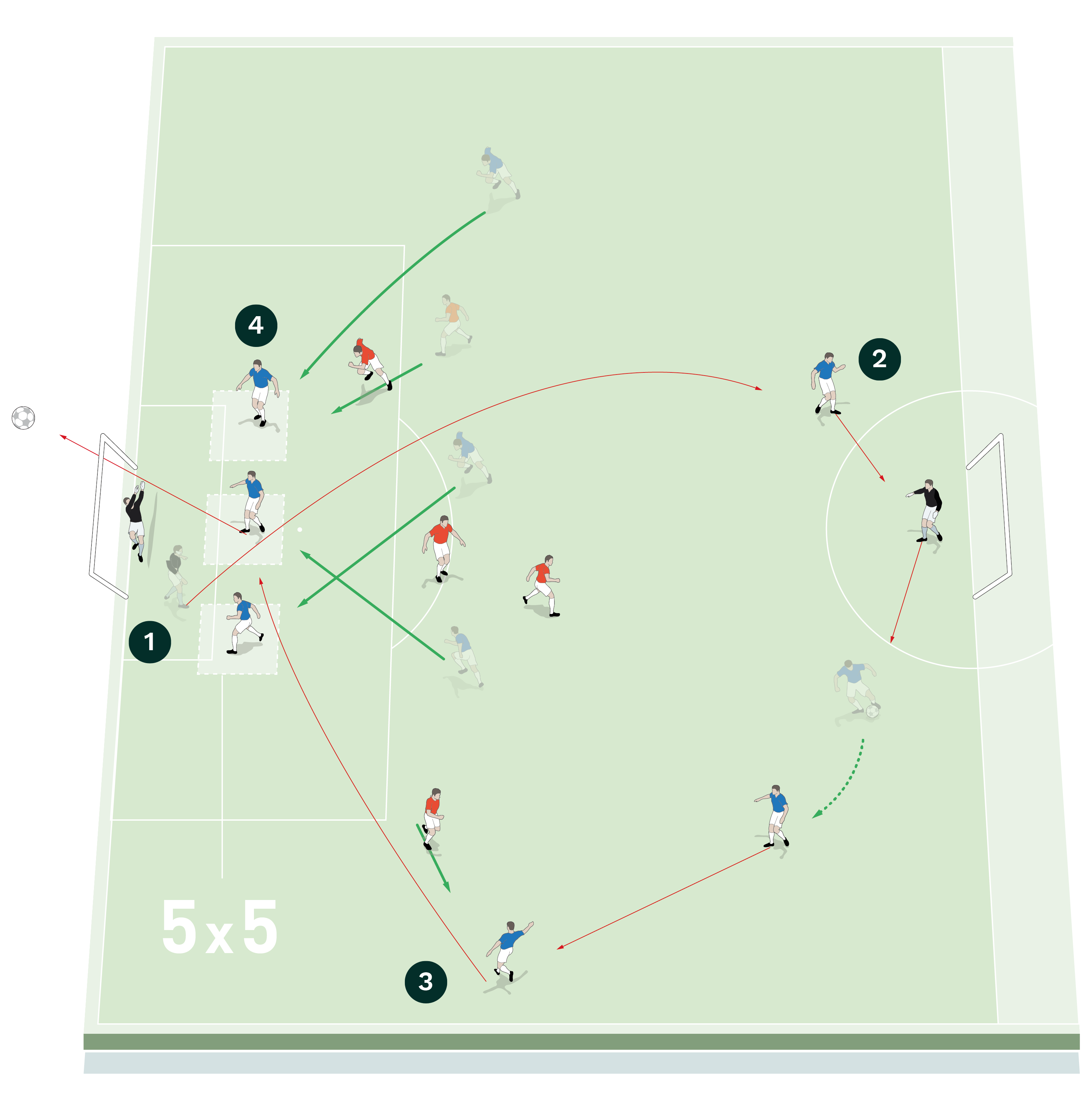
2. A player from the blue team receives the goal kick from the opposition keeper and the blues launch an attack built from the back via the wide areas
3. The blue wide player crosses accurately into the penalty area
4. The attacking team has just 10 seconds to score, so the attackers must time their runs well to get into the optimal finishing boxes.
The attacking blue team should try to create 2v1 overloads in wide areas when the opportunity arises, as shown [3b]. If the red defending team wins the ball they should counter-attack and score a goal past the blue team’s goalkeeper.
[3b]
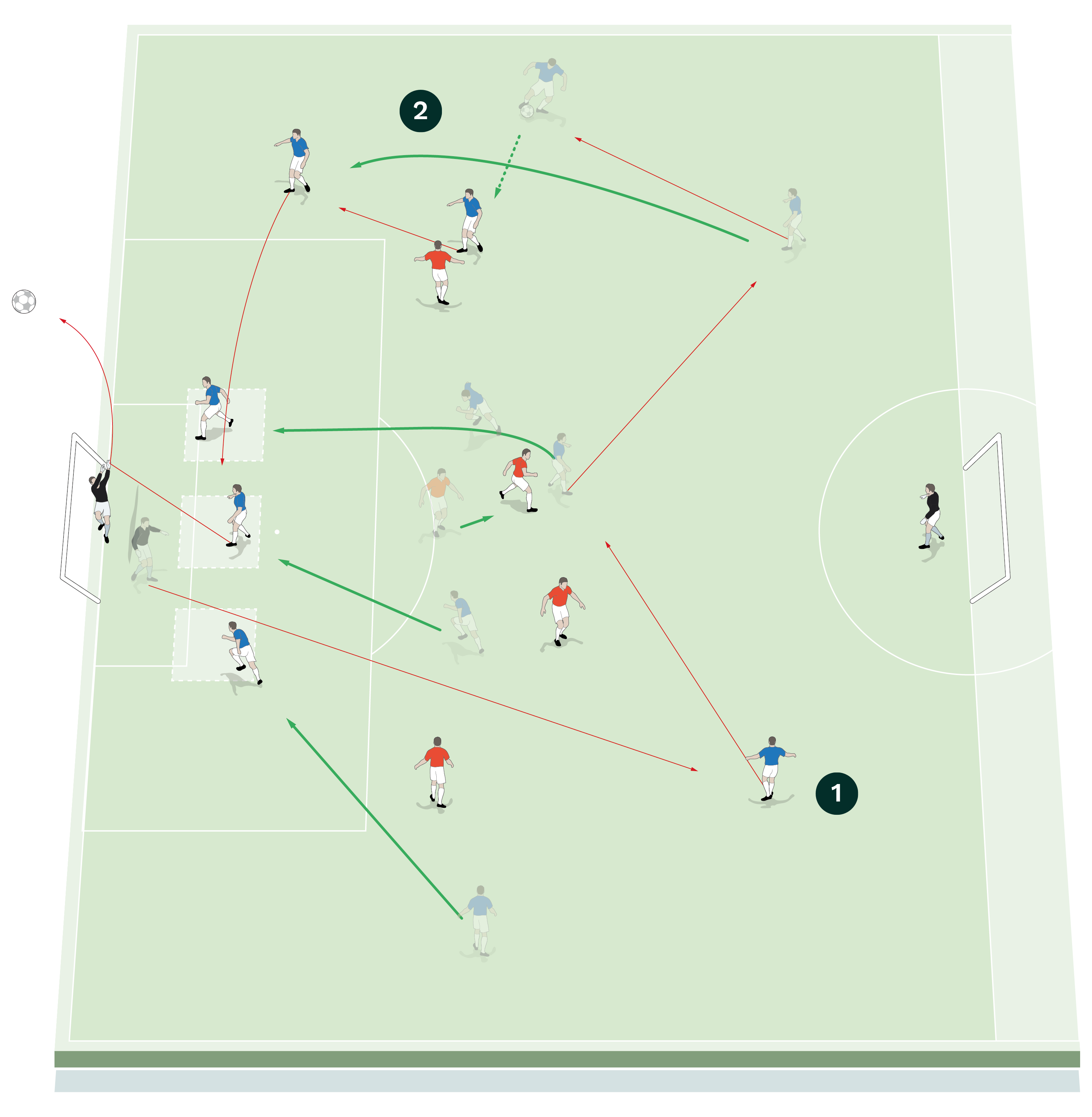
2. The attacking blue team try to create 2v1 overloads in wide areas when the opportunity arises
COACHING POINTS
What are the key things to look for?
We want to see a smooth transition from defence to attack, with quick passes made to the wide players. The attacking players must support the wide pass and make intelligent runs into opposition penalty box to meet the cross.
The defending team needs to get back into good defensive positions to clear the danger, particularly around the front post, and the attacking players need to time their runs to create spaces in and around the box. The positions of both the defenders and the attackers will depend on the timing of the crosses, the direction of the crosses and the speed of the crosses.
What are the typical mistakes players might make and how do I avoid them?
Sometimes the transitions are too slow, which can allow defenders to get back into good positions. Another common problem occurs if crosses are either over hit or fail to get past the first defender.
We need to encourage good and quick decision making from the wide players because if they are too slow to react, the cross can be poorly executed when players are already making runs to finish from it.
Editor's Picks
Attacking transitions
Deep runs in the final third
Using the goalkeeper in build-up play
Intensive boxes drill with goals
Penetrating the final third
Creating and finishing
My philosophy
Pressing initiation
Compact team movement
Coaches' Testimonials

Alan Pardew

Arsène Wenger

Brendan Rodgers

Carlos Carvalhal

José Mourinho

Jürgen Klopp

Pep Guardiola

Roy Hodgson

Sir Alex Ferguson

Steven Gerrard
Coaches' Testimonials

Gerald Kearney, Downtown Las Vegas Soccer Club

Paul Butler, Florida, USA

Rick Shields, Springboro, USA

Tony Green, Pierrefonds Titans, Quebec, Canada
Join the world's leading coaches and managers and discover for yourself one of the best kept secrets in coaching. No other training tool on the planet is written or read by the calibre of names you’ll find in Elite Soccer.
In a recent survey 92% of subscribers said Elite Soccer makes them more confident, 89% said it makes them a more effective coach and 91% said it makes them more inspired.
Get Monthly Inspiration
All the latest techniques and approaches
Since 2010 Elite Soccer has given subscribers exclusive insight into the training ground practices of the world’s best coaches. Published in partnership with the League Managers Association we have unparalleled access to the leading lights in the English leagues, as well as a host of international managers.
Elite Soccer exclusively features sessions written by the coaches themselves. There are no observed sessions and no sessions “in the style of”, just first-hand advice delivered direct to you from the coach.









